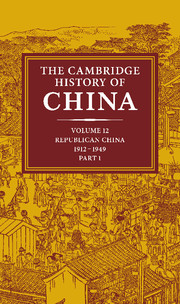Book contents
- Frontmatter
- 1 Introduction: Maritime and continental in China's history
- 2 Economic trends, 1912–49
- 3 The foreign presence in China
- 4 Politics in the aftermath of revolution: the era of Yuan Shih-k'ai, 1912–16
- 5 A constitutional republic: the Peking government, 1916–28
- 6 The warlord era: politics and militarism under the Peking government, 1916–28
- 7 Intellectual change: from the Reform movement to the May Fourth movement, 1895–1920
- 8 Themes in intellectual history: May Fourth and after
- 9 Literary trends I: the quest for modernity, 1895–1927
- 10 The Chinese Communist Movement to 1927
- 11 The Nationalist Revolution: from Canton to Nanking, 1923–28
- 12 The Chinese bourgeoisie, 1911–37
- Bibliographical essay
- Bibliography
- Index
- Republican China – physical features
- References
2 - Economic trends, 1912–49
Published online by Cambridge University Press: 28 March 2008
- Frontmatter
- 1 Introduction: Maritime and continental in China's history
- 2 Economic trends, 1912–49
- 3 The foreign presence in China
- 4 Politics in the aftermath of revolution: the era of Yuan Shih-k'ai, 1912–16
- 5 A constitutional republic: the Peking government, 1916–28
- 6 The warlord era: politics and militarism under the Peking government, 1916–28
- 7 Intellectual change: from the Reform movement to the May Fourth movement, 1895–1920
- 8 Themes in intellectual history: May Fourth and after
- 9 Literary trends I: the quest for modernity, 1895–1927
- 10 The Chinese Communist Movement to 1927
- 11 The Nationalist Revolution: from Canton to Nanking, 1923–28
- 12 The Chinese bourgeoisie, 1911–37
- Bibliographical essay
- Bibliography
- Index
- Republican China – physical features
- References
Summary
INTRODUCTION: AN OVERVIEW
To survey the history of the Chinese economy from the end of the Manchu dynasty to the establishment of the People's Republic is inevitably to tell a tale in a minor key. The years prior to 1949 saw no ‘take off’ towards sustained growth of aggregate output and the possibility of increased individual welfare that might accompany it. At best, the great majority of Chinese merely sustained and reproduced themselves at the subsistence level to which, the callous might say, they had long since become accustomed. In the bitter decade of war and civil war which began in the mid 1930s, the standard of life for many fell short even of that customary level.
A cautious weighing of what little is definitely known suggests that aggregate output grew only slowly during 1912–49, and that there was no increase in per capita income. Nor was there any downward trend in average income. Although a small modern industrial and transport sector, which first appeared in the late nineteenth century, continued to grow at a comparatively rapid rate, its impact was minimal before 1949. The relative factor supplies of land, labour and capital remained basically unaltered. The occupational distribution of the population was hardly changed; nor in spite of some expansion of the urban population was the urban-rural ratio significantly disturbed during these four decades. While some new products were introduced from abroad and from domestic factories, quantitatively they were a mere dribble, and they scarcely affected the quality of life. Institutions for the creation of credit remained few and feeble; the organization of a unified national market was never achieved.
Keywords
- Type
- Chapter
- Information
- The Cambridge History of China , pp. 28 - 127Publisher: Cambridge University PressPrint publication year: 1983
References
- 7
- Cited by

